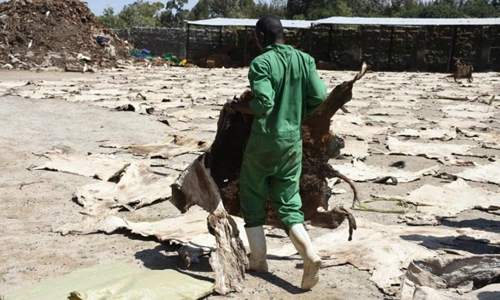Slaughterhouses in Kenya are operating at full capacity to meet the demand for donkey skin for Chinese medicine.
But campaigners warn that the situation could have "terrible effects" on the lives of impoverished communities in Kenya when it creates a black market that raises donkey theft.

A donkey slaughterhouse in Kenya Photo: Donkey Sanctuary
Many donkeys are also smuggled from Ethiopia, Uganda, Tanzania and South Sudan into Kenya to supply factories because Kenya is the only East African country with licensed donkey abattoirs.
Donkey skin is sold to China and then processed into "ejiao", a traditional remedy that can improve blood circulation and treat conditions like anemia. But most families living in arid and semi-arid areas in East Africa depend on donkeys to transport goods and heavy objects.
"I believe that if Chinese consumers understand that the lives of African families, women and children are in trouble because of the loss of a trick, they will view the product completely. ", Petra Ingram, chief executive of Brooke, the international animal rights charity, spoke last week at the 2019 Donkey Trade Conference in Nairobi. "For some families, donkeys are the only source of income. We want to ban exports of donkey skins and related products."
"We are facing a crisis in Kenya because 1,000 donkeys are being killed every day. In the past three years, they have killed more than 300,000 donkeys," he said. "The demand for ejiao has increased dramatically in recent years. This product has had a terrible impact on the lives of people in Africa and around the world."
In East Africa, Brooke is working with the Donkey Conservation Area and the Overseas Animal Protection Association, both charities from the UK, and local organizations to advocate for a ban on leather trade. and donkey meat.
The decline in the number of domestic donkeys forces Chinese ejiao producers to source supplies abroad. A new study warns this trend could wipe out the number of donkeys in markets like Kenya within three years.
Because of the urbanization process and the fact that many people are giving up farming, the number of donkeys in China has decreased from about 11 million in the 1990s to three million today, according to the main data. covered.
Deng Gai, representing South Sudan in the East African Legislative Council, said that Tanzania had previously banned the export of donkey products but was seeking to loosen regulations after Kenya's donkey slaughterhouses were licensed.
"They are selling all the tricks to Kenya, so they ask themselves," What is the meaning of banning the trade of trick? ", Deng said at a conference in Nairobi." That's why we need a holistic approach. area".
"Why do we have to kill so many donkeys just because a part of people in society believes that a skin product can change their life?", She asked.
A recent study conducted by the Kenya Agricultural and Livestock Research Organization in collaboration with the National Bureau of Statistics and the Kenya General Department of Animal Health found that at four licensed slaughterhouses of the country, a total of 301,977 donkeys were were killed from 2016 to 2018.
"If such a situation continues without appropriate intervention, the number of donkeys will be depleted by 2022," the study concludes.
Kenya's number of donkeys in 2009 reached 1.8 million, but according to Brooke branch in East Africa, the number has significantly reduced since then.
Increasing international demand for donkey skins has led some African countries such as Botswana, Ethiopia, Mali, Niger or Senega to ban exports of donkey products.
Burkina Faso stopped exporting donkeys after 45,000 donkeys from the herd total 1.4 million were killed in just six months. Nigeria is also discussing a bill to ban exports of live donkeys or their carcasses.
The Donkey Conservation Research study warns that China's need to buy donkeys for medicinal use is also likely to halve the number of donkeys in Asia, Africa and South America in at least another 5 years if the government does not enter. control.
China is using about 4.8 million donkeys every year to produce ejiao but it cannot meet the demand from domestic supply and has to import more from Africa, Asia and South America.



 JohnClark
JohnClark







